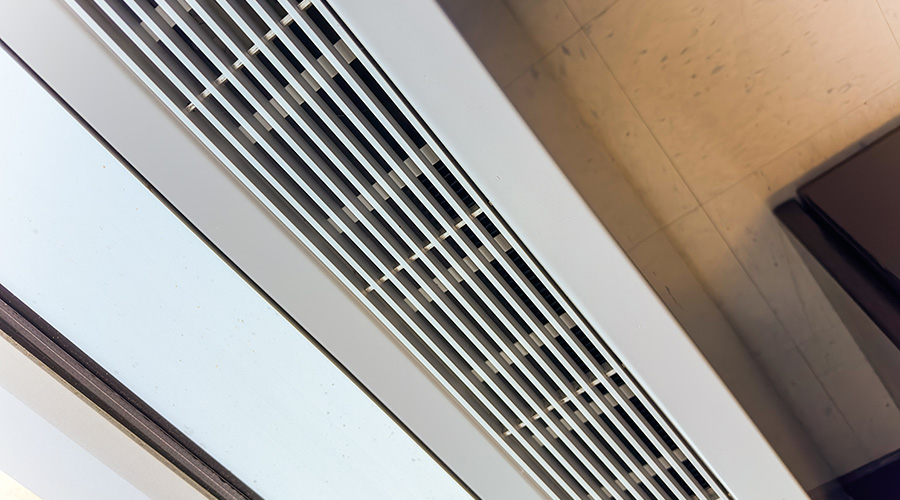Air Check: Monitoring for IAQ
Monitoring technology advances in response to facilities’ growing need to provide healthier indoor environments
Facilities use huge amounts of air for environmental conditioning daily. But increasingly, building occupants and managers alike are asking tougher questions about the condition of that air. News reports of building mold have only increased awareness of indoor air quality (IAQ) as both a health issue and a roadblock to productivity.
Understanding the source of materials that cause IAQ problems, as well as the technology to detect and remove these materials, can help managers implement and fine-tune air-monitoring programs.
IAQ Culprits
Studies by the National Institute of Occupational Safety and Health (NIOSH) indicate that more than one-half of IAQ problems stem from inadequate ventilation. Other major causes are:
- indoor airborne contaminants, including dust and vapors
- outdoor contaminants, such as exhaust fumes, pollen, smoke and dust
- microbial contaminants
- building furnishings and fabrics.
Ventilation-based problems, however, occur more than three times more frequently than the next leading cause and exceed all other causes combined. Better ventilation can reduce not only this dominant cause of pollution but all others, as well. Other factors to consider in overall air quality are temperature, humidity and noise.
Methods for removing air pollutants include increased ventilation, pollutant course control and air cleaners that include carbon filters, mechanical filters, electromagnetic precipitators and desiccants to remove bioaerosols, particulates, organic chemicals and smoke.
Equipment Checks
In many cases, the primary reasons for inadequate ventilation often are poor maintenance and a large backlog of deferred maintenance. Action is likely to be required if an inspection of a facility reveals any of these situations:
- air-intake or exhaust-filter access doors propped open
- dirty filters
- poor housekeeping in mechanical equipment spaces
- mechanical equipment space used as storage areas
- improper steam trapping
- plugged strainers
- shut-down fans
- energy management system or humidifiers turned off
- water heaters offline
- chiller stages not operating
- missing insulation
- cooling towers that are dirty or have slime build-up
- visible pipe leaks
- inoperative variable-air-volume controls or air louvers
- dirty, dust-filled air ducts.
Serious liability due to illness, safety hazards, and even death can occur if these symptoms are left unattended. If they are widespread, managers should film them with a video camera and show them to facility administrators, whose support will be crucial in remedying these problems.
The Goal of Monitoring
The goal of monitoring indoor air is to create and maintain a safe and healthy environment. The first thing to monitor is air changes per hour. The required number of air changes depends on the number of occupants and should equate to 15-20 cubic feet per minute (CFM). Managers also must consider additional factors, such as the efficiency of the air-handling equipment, outside-air quality, and recommended air ratios between supply and exhaust air volume.
Occupancy levels change over time. A system’s original design might have been developed with different specifications in mind, so it is useful to check building design data when assessing current IAQ. Design data includes HVAC requirements, including the number and type of fans and their design ratings. Managers will need to check whether fans, filters and ducts are clean and still working properly.
Monitoring also should include temperature and humidity. These elements are measured together to determine how each relates to the other. As outside-air temperatures drop, the humidity of the inside air declines. A range of 40-60 percent relative humidity (RH) is best for comfort and health.
Without humidity correction, inside air can reach 25 percent RH in winter, and respiratory and skin problems can increase, due to the drying of skin tissue and mucous membranes. On the other hand, high humidity can create a breeding ground for microbes, fungi and pollen, which can be ingested through cuts and the respiratory system.
The best control of dust and other particulates carried in from the outside or generated inside occurs at the source. Managers should consider using entrance mats to keep outside contaminants from entering buildings. Crews should clean mats daily by vacuuming with a vacuum that uses a high-efficiency particulate-arrestance (HEPA) filter to control inside dust. Crews should perform other dust-causing operations, such as floor and carpet cleaning, with properly filtered cleaning equipment, rather than by sweeping.
Monitoring Technology
Addressing a reported problem as part of an IAQ program can be done using in-house resources, conferring with the supplier of air-handling equipment, or using a testing lab in the area. A log of reported problems should contain the nature of the problem, the person who reported it, when the problem occurred and outdoor weather conditions.
Monitors come in personal, portable and stationary varieties. Active-type monitors draw air into a sampler and do real-time analysis. With passive-types, air diffuses into a sampler, so a longer time is required for accurate results.
Managers can specify personal monitors for measuring concentrations of inorganic gases, such as carbon dioxide (CO2), carbon monoxide (CO), nitrogen dioxide (NO2), and sulfur dioxide (SO2). One frequently used CO monitor can measure 1,600 data points in 24 hours with automatic data logging. It continually draws air through a pump to a deionized water cell. The CO reacts with water, and the CO concentration in the air is read directly from an LED display.
Among the most frequently used NO2 monitors is the Palmes tube. Three stainless-steel tubes coated with triethanolamine are fitted to one end of an acrylic tube. The other end has a cap that is removed to collect the air to be sampled. NO2 accumulated on the screens is washed with a reagent. NO22. The active sampler uses a 0.8mm Nuclepore filter, reducing sample to one-eight hours.
Portable and Stationary Samplers
Four types of portable and stationary samplers are air displacement, condensation, gas washing — absorption — and adsorption.
In the air-displacement method, a sample is collected in an evacuated flask or plastic bag. In the condensation method, a sample is passed through a U-tube and the sample is cooled below the pollutant's boiling point.
Gas washing is done by bubbling the sample through an impinger liquid that the sample dissolves in or reacts with. Adsorption uses activated carbon, silica gel, molecular sieves, or polymeric filters. Some examples of monitors and their uses are:
concentration is proportional to the color intensity of the solution. This method requires at least 24 hours of sample time to collect a minimum of 0.05 mg of NO
- Hot-wire detector. This monitor works on a thermal conductivity principle and measures concentrations of inorganic gases.
- Flame-ionization detector. This monitor uses a sample of hydrogen to measure concentrations of alipathic and aromatic hydrocarbons.
- Electron-capture detector. This technology measures current flow between electrodes due to ionization of gases by a radioactive source and is used to detect chlorinated hydrocarbons.
- Flame-photometric detector. This unit measures light emitted from the excited states of sulfur and phosphorous compounds in a hydrogen flame.
- Mass-selective detector. This technology provides a quantitative analysis of most indoor pollutants and can identify unknown chemicals in a mixture.
Matching Needs and Technology
Note that all but the last device require that the user know or suspect the presence of a certain pollutant before selecting the right monitor. For this reason, it is important to know about building and furnishing materials, processes such as combustion and chemical reactions in a chemistry lab, and outdoor pollutants in the area.
Most often, a thermal-conductivity detector is used with either the flame ionization detector, electron-capture detector or flame-photometric detector in series.
One available monitoring system offers users the ability to monitor airflow volume, CO2, RH, temperature, CO, and pressure differential. It can be used as a continuous or spot monitor.
Gas analyzers for boiler rooms measure levels of toxic gases, including CO, nitric oxide, nitric dioxide, and SO2. Leak detectors can reveal several refrigerants, including R12, R22, and R502 with one instrument by changing the position of a switch.
The ongoing challenge for managers is to stay abreast of monitoring and filtration technology and conditions within their facilities. The causes of IAQ can be widespread, and each facility is different, so matching technology to these conditions is an ongoing effort, not a one-time event.
IAQ: Beyond Monitoring
Managers have options besides monitoring that, along or in combination, can help them take control of their facilities' indoor air quality (IAQ):
Source control. Source control as a means of controlling IAQ received new credibility as a result of a test conducted during the construction of an office building. The entire building was built using new construction methods and building-material combinations. Techniques included hardwood floors, wool rugs, no carpets, no office partitions, and metal and wool furniture and furnishings. Paint and wallpaper use was minimized throughout.
Investigators compared the office building’s IAQ to two buildings constructed with traditional methods. Concentrations of 23 organic compounds were measured in all three buildings. Total volatile organic compounds (VOCs) in the new building were much lower than in the two traditional buildings.
Ventilation. Even when source control is used, proper ventilation must be maintained to minimize VOCs. Besides providing proper air changes per hour for the number of occupants and use of the building space, managers must continue to improve ventilation.
Methods that provide adequate ventilation while conserving energy, such as improved economizer designs, are in demand. Also, air-to-air heat exchangers allow for more frequent air changes while reducing energy demands by recovering heat from the exhaust air — up to 85 percent — and reusing heat in the supply air in cold weather and the reverse in warm weather.
Air cleaning. Developments related to catalytic converters for building use are under way. Added to activated-charcoal adsorbers, for example, platinum catalysts increase the absorber efficiency substantially.
Care is needed to ensure that the converter does not convert a slightly hazardous material into a more hazardous one. An example is the electrostatic precipitator that removes 99 percent of respiratory particulates but adds ozone to the air.
Humidity also affects air cleaners’ efficiency. Greater use of humidifiers and dehumidifiers will control this air-quality factor to 40-60 percent RH, the most healthy range for occupants.
|
Related Topics:











